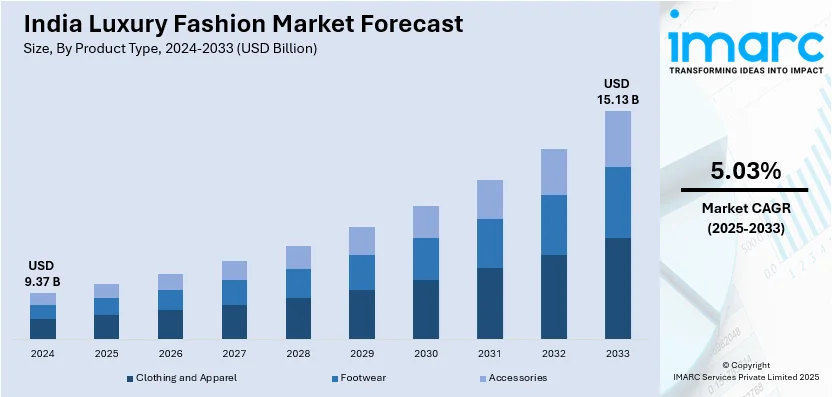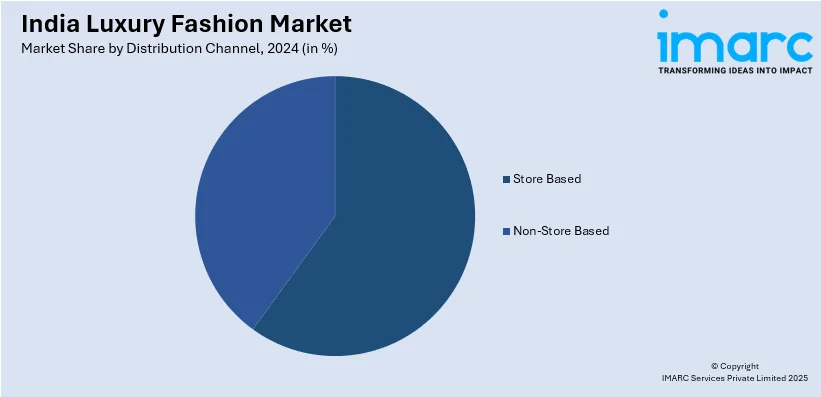
India Luxury Fashion Market Size, Share, Trends and Forecast by Product Type, Distribution Channel, End User, and Region, 2025-2033
India Luxury Fashion Market Overview:
The India luxury fashion market size reached USD 9.37 Billion in 2024. Looking forward, IMARC Group expects the market to reach USD 15.13 Billion by 2033, exhibiting a growth rate (CAGR) of 5.03% during 2025-2033. The rising disposable incomes, increasing brand consciousness, growing demand for sustainable fashion, digital transformation, influencer marketing, evolving consumer preferences, premiumization trends, and the expansion of global luxury brands into the Indian retail landscape is augmenting the India luxury clothing market share.
|
Report Attribute
|
Key Statistics
|
|---|---|
|
Base Year
|
2024 |
|
Forecast Years
|
2025-2033
|
|
Historical Years
|
2019-2024
|
| Market Size in 2024 | USD 9.37 Billion |
| Market Forecast in 2033 | USD 15.13 Billion |
| Market Growth Rate 2025-2033 | 5.03% |
India Luxury Fashion Market Trends:
Rising Demand for Sustainable and Ethical Luxury Fashion
The India luxury clothing market growth is driven by a significant shift towards sustainable and ethical fashion, driven by increasing consumer awareness and environmental concerns. For instance, India is among the participating nations in a six-year, USD 45 Million program that was introduced on December 9, 2024, to lessen the environmental impact of the fashion and building industries. By replacing non-renewable materials, encouraging resource-efficient production, and encouraging responsible purchasing practices, this program seeks to advance regenerative design. To increase its impact, the program also makes use of an extra USD 295 Million from external sources. Luxury brands are integrating eco-friendly fabrics, organic dyes, and ethical sourcing practices to appeal to environmentally conscious buyers. The growing preference for slow fashion, emphasizing quality and longevity over mass production, is further shaping market trends. Additionally, Indian consumers are favoring brands that promote fair trade, cruelty-free production, and carbon-neutral operations. This trend is encouraging both global and domestic luxury brands to adopt responsible fashion practices, enhancing their appeal in the evolving Indian luxury clothing segment.

To get more information on this market, Request Sample
Increasing Influence of Digital and Omni-Channel Retail
The luxury clothing market in India is experiencing rapid digital transformation, with brands leveraging e-commerce and omni-channel strategies to improve consumer engagement. High-end fashion houses are investing in online flagship stores, AI-driven personalization, and virtual try-on experiences to cater to tech-savvy shoppers. Social media and influencer collaborations are further driving brand visibility, influencing purchasing decisions. Moreover, luxury brands are integrating online and offline experiences through exclusive in-store services, digital concierge assistance, and seamless payment options, which in turn is positively impacting India luxury clothing market outlook. The increasing adoption of augmented reality (AR) and virtual reality (VR) is also elevating the digital luxury shopping experience in India. For instance, according to a report released by the Press Information Bureau on January 28, 2025, India's digital economy made up 11.74% of the country's GDP in 2022–2023, or about INR 31.64 Lakh Crore (USD 402 Billion). This industry had a productivity level that was over five times higher than that of other economic sectors, and it employed 14.67 million people, or 2.55% of the total workforce in the country. Forecasts suggest that by 2029–2030, the digital economy will account for 20% of GVA, overtaking more established industries like manufacturing and agriculture.
India Luxury Fashion Market Segmentation:
IMARC Group provides an analysis of the key trends in each segment of the market, along with forecasts at the country level for 2025-2033. Our report has categorized the market based on product type, distribution channel, and end user.
Product Type Insights:
- Clothing and Apparel
- Jackets and Coats
- Skirts
- Shirts and T-Shirts
- Dresses
- Trousers and Shorts
- Denim
- Underwear and Lingerie
- Others
- Footwear
- Accessories
- Gems and Jewellery
- Belts
- Bags
- Watches
The report has provided a detailed breakup and analysis of the market based on the product type. This includes clothing and apparel (jackets and coats, skirts, shirts and T-shirts, dresses, trousers and shorts, denim, underwear and lingerie, and others), footwear, and accessories (gems and jewellery, belts, bags, and watches).
Distribution Channel Insights:

- Store Based
- Non-Store Based
A detailed breakup and analysis of the market based on the distribution channel have also been provided in the report. This includes store based and non-store based.
End User Insights:
- Men
- Women
- Unisex
A detailed breakup and analysis of the market based on the end user have also been provided in the report. This includes men, women, and unisex.
Regional Insights:
- North India
- South India
- East India
- West India
The report has also provided a comprehensive analysis of all the major regional markets, which include North India, South India, East India, and West India.
Competitive Landscape:
The market research report has also provided a comprehensive analysis of the competitive landscape. Competitive analysis such as market structure, key player positioning, top winning strategies, competitive dashboard, and company evaluation quadrant has been covered in the report. Also, detailed profiles of all major companies have been provided.
India Luxury Fashion Market News:
- On October 25, 2024, Kalpraag debuted its 'Naayab' collection with the goal of bringing reasonably priced luxury to the Indian ethnic wear market. With a name that means "rare" or "precious" in Hindi, the collection includes a variety of Jodhpuri and kurta sets that combine classic silhouettes with modern artistic motifs. This launch marks an important turning point for Kalpraag and demonstrates the brand's dedication to crafting imaginative stories using traditional Indian clothing.
- On March 18, 2025, the eighth edition of the PEAKLIFE Regatta, which combined luxury and nautical adventure, took place in Mumbai, India. With the picturesque Gateway of India as a backdrop, the event showcased fashion designer Varoin Marwah's 'Coastal Calm SS '25' collection, which was inspired by marine hues and sandy tones. Attendees had the opportunity to enjoy an exciting nautical experience as four teams—PEAKLIFE, Chivas, Louisiana, and SWISS—sailed from the Gateway of India as part of the regatta.
India Luxury Fashion Market Report Coverage:
| Report Features | Details |
|---|---|
| Base Year of the Analysis | 2024 |
| Historical Period | 2019-2024 |
| Forecast Period | 2025-2033 |
| Units | Billion USD |
| Scope of the Report | Exploration of Historical Trends and Market Outlook, Industry Catalysts and Challenges, Segment-Wise Historical and Future Market Assessment:
|
| Product Types Covered |
|
| Distribution Channels Covered | Store Based, Non-Store Based |
| End Users Covered | Men, Women, Unisex |
| Regions Covered | North India, South India, East India, West India |
| Customization Scope | 10% Free Customization |
| Post-Sale Analyst Support | 10-12 Weeks |
| Delivery Format | PDF and Excel through Email (We can also provide the editable version of the report in PPT/Word format on special request) |
Key Benefits for Stakeholders:
- IMARC’s industry report offers a comprehensive quantitative analysis of various market segments, historical and current market trends, market forecasts, and dynamics of the India luxury fashion market from 2019-2033.
- The research report provides the latest information on the market drivers, challenges, and opportunities in the India luxury fashion market.
- Porter's five forces analysis assist stakeholders in assessing the impact of new entrants, competitive rivalry, supplier power, buyer power, and the threat of substitution. It helps stakeholders to analyze the level of competition within the India luxury fashion industry and its attractiveness.
- Competitive landscape allows stakeholders to understand their competitive environment and provides an insight into the current positions of key players in the market.
Key Questions Answered in This Report
The India luxury fashion market size reached USD 9.37 Billion in 2024.
The India luxury fashion market market is expected to grow to USD 15.13 Billion by 2033, exhibiting a CAGR of 5.03% during 2025-2033.
Growth is driven by increasing disposable incomes, a growing aspirational middle class, and greater exposure to global fashion trends through social media and digital platforms. Urbanization and the rise of high-net-worth individuals (HNWIs) are fueling demand for premium apparel, accessories, and footwear. The expansion of luxury retail outlets and online platforms, along with celebrity endorsements and luxury brand collaborations, is also boosting market visibility and consumer engagement. Additionally, evolving consumer preferences for high-quality, branded, and exclusive products are further accelerating market growth across the country.
Need more help?
- Speak to our experienced analysts for insights on the current market scenarios.
- Include additional segments and countries to customize the report as per your requirement.
- Gain an unparalleled competitive advantage in your domain by understanding how to utilize the report and positively impacting your operations and revenue.
- For further assistance, please connect with our analysts.
 Request Customization
Request Customization
 Speak to an Analyst
Speak to an Analyst
 Request Brochure
Request Brochure
 Inquire Before Buying
Inquire Before Buying




.webp)




.webp)












